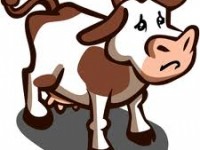Rumen Acidosis Rumen acidosis is a metabolic disease of cattle. Like most metabolic diseases it is important to remember that for every cow that shows clinical signs, there will be several more which are affected sub-clinically.
Acidosis is said to occur when the pH of the rumen falls to less than 5.5 (normal is 6.5 to 7.0). In many cases the pH can fall even lower. The fall in pH has two effects. Firstly, the rumen stops moving. This depresses appetite and production. Secondly, the change in acidity changes the rumen micro-organisms, with acid-producing bacteria taking over. They produce more acid, making the acidosis worse. The increased acid is then absorbed through the rumen wall, causing metabolic acidosis, which in severe cases can lead to shock and death.
Cause
The primary cause of acidosis is feeding a high level of rapidly digestible carbohydrate, such as fsecond rotation grass, wheat, barley and other cereals.
In dairy cattle, sub-acute acidosis, is seen as a result of feeding large amounts of second rotation lush leafy grass with low fibre and in increased concentrates compared to forage. Wet grazing conditions on lush leafy grass make this situation worse.
Symptoms
- Cattle may become depressed,
- Go off feed,
- Have an elevated heart rate or diarrhea.
- Sub-acute: Reduced feed intake Poor body condition and weight loss
- Unexplained diarrhoea Temperature Pulse rate and respiratory rate may rise
- Lethargy.
Prevention
The key to prevention is reducing the amount of readily fermentable carbohydrate consumed at each meal. This requires both good diet formulation (proper balance of fiber and nonfiber carbohydrates) and excellent feed management. You could have the best feed formulation in the world but if there is excessive competition for feed space cattle will tend to gorge when they get to the feed passage. This is a common problem where herd numbers have gone up but feed space has not been increased to compensate. Also this is very common when grass supply is tight and cows are coming in hungry.
Feeding excessive quantities of concentrate and insufficient forage results in a fibre-deficient ration likely to cause subacute ruminal acidosis. The same situation may be seen during the last few days before parturition if the ration is fed in separate components. Including long-fiber particles in the diet reduces the risk of subacute ruminal acidosis by encouraging saliva production during chewing and by increasing rumination after feeding. However, long-fiber particles should not be easily sorted away from the rest of the diet; this could delay their consumption until later in the day or cause them to be refused completely.
Ruminant diets should also be formulated to provide adequate buffering. This can be accomplished by feedstuff selection and/or by the addition of dietary buffers such as sodium bicarbonate or potassium carbonate. Dietary anion-cation difference is used to quantify the buffering capacity of a diet. Supplementing the diet with direct-fed microbials that enhance lactate utilizers in the rumen may reduce the risk of subacute ruminal acidosis. Yeasts, propionobacteria, lactobacilli, and enterococci have been used for this purpose.
In Summary Rumen Acidosis can have a huge negative impact into dairy and beef animals production capabilities. In Ireland grazing lush leafy highly fermentable grass is a huge challenge to prevent acidosis and indeed it will affect most animals to a greater or lesser extent. The key is understanding what it is and how best to minimise the impact it has on your herd.
Talk to our Sales team on 061 355186 who have been trained in helping advise on coping with acidosis.

